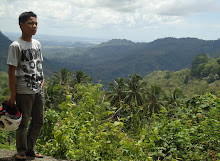The water cycle or hydrologic cycle is the circulation of water that never stops from the atmosphere to the earth and back to the atmosphere through condensation, precipitation, evaporation and transpiration.Warming sea water by sunlight is a key hydrologic cycle process can be run continuously. Air berevaporasi, then falls as precipitation in the form of rain, snow, hail, sleet and snow (sleet), drizzle or fog.On the way to the earth some precipitation may berevaporasi back up or fell were later intercepted by plants before it reaches the ground. Upon reaching the ground, the hydrological cycle is continuously moving in three different ways:• Evaporation / transpiration - water that is in the sea, on land, in rivers, on plants, and so on. then will evaporate into the air (atmosphere) and then it will be a cloud. In the saturated state of water vapor (clouds) it would be water spots which will further fall (precipitation) in the form of rain, snow, ice.• Infiltration / Percolation into the ground - water moves into the soil through cracks and pores of the soil and rock into the groundwater. Water can move due to capillary action or water can move vertically or horizontally below the ground surface to the water re-entering the surface water system.• Surface Water - Water moves above the soil surface close to the main stream and lake; increasingly sloping land and fewer pores of the soil, the greater the runoff. Surface flow can be seen usually in urban areas. The rivers join each other and form a major river that carries across the water surface around the watershed to the sea.Surface water, either flowing or stagnant (lakes, reservoirs, marshes), and some subsurface water will be collected and flows to form the river and ended at the sea. Process water trip on the mainland occurred in the hydrologic cycle components that make up the watershed system (DAS). Amount of water in the world as a whole is relatively fixed, the change is the form and place.
Hydrological cycle is the circulation of water that never stops from the atmosphere to the earth and back to the atmosphere through condensation, precipitation, evaporation and transpiration. Ocean water heating by the sun is a key hydrologic cycle processes can be run continuously. Air berevaporasi, then falls as precipitation in the form of rain, snow, hail, sleet and snow (sleet), drizzle or fog. On the way to the earth some precipitation may berevaporasi back up or fell were later intercepted by plants before it reaches the ground. Upon reaching the ground, the hydrological cycle is continuously moving in three different ways:• Evaporation / transpiration - water that is in the sea, on land, in rivers, on plants, and so on. then will evaporate into the air (atmosphere) and then it will be a cloud. In the saturated state of water vapor (clouds) it would be water spots which will further fall (precipitation) in the form of rain, snow, ice.• Infiltration / Percolation into the ground - water moves into the soil through cracks and pores of the soil and rock into the groundwater. Water can move due to capillary action or water can move vertically or horizontally below the ground surface to the water re-entering the surface water system.• Surface Water - Water moves above the soil surface close to the main stream and lake; increasingly sloping land and fewer pores of the soil, the greater the runoff. Surface flow can be seen usually in urban areas. The rivers join each other and form a major river that carries across the water surface around the watershed to the sea. Surface water, either flowing or stagnant (lakes, reservoirs, marshes), and some subsurface water will be collected and flows to form the river and ended at the sea. The process of water on land that occurs in components that make up the hydrologic cycle systems of the Watershed (DAS). Amount of water in the world as a whole is relatively fixed, the change is a form and place.
Keywords:Evaporation (Evaporation)When water is heated by the sun, the surface of the water molecules have enough energy to break the bonds of the water molecule and then detached and expands as invisible water vapor in the atmosphere. Approximately 95,000 cubic miles of water evaporates into the air each year. Nearly 80,000 square miles of ocean evaporation. Only 15,000 square miles from land, lakes, rivers, and wet land, and most importantly also from tranpirasi by living plant leaves. The process they are called Evapotranspiration.Transpiration (evaporation from plants)Water vapor is also released from the leaves of the plant through a process called transpiration. Every day actively growing plants release water vapor 5 to 10 times as much water can be held.Condensation (condensation)When the water vapor expands, it cools and then condenses, usually on small dust particles in the air. When condensation occurs can turn into liquid again or turns directly into a solid (ice, snow, hail (hail)). Water particles are then assembled to form clouds.PrecipitationPrecipitation in the formation of rain, snow and hail (hail) derived from a collection of clouds. The clouds are moving around the world, which is governed by air currents. For example, when the clouds are moving towards the mountains, the clouds became cold, and then quickly became saturated water and then the water falls as rain, snow, and hail (hail), depending on the temperature of the surrounding air.Percolation / infiltrationSome precipitation and melting snow moves into the lower layers of the soil, infiltration or percolation flow through cracks and pores of the soil and rock that reaches the ground water (water table), which later became the underground water.



0 komentar:
Posting Komentar